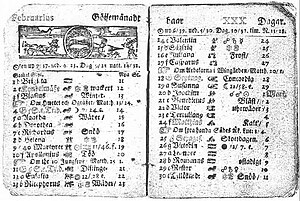List of non-standard dates
February 30occurs in some calendars, but not in theGregorian calendar,whereFebruarycontains only 28 or in a leap year, 29 days.
Swedish calendar

TheSwedish Empire(which includedFinlandat the time) planned to change from theJulian calendarto the Gregorian calendar beginning in 1700 by omittingleap daysfor the next 40 years. Although the leap day was omitted in February 1700, theGreat Northern Warbegan later that year, diverting the attention of the Swedes from their calendar so they did not omit leap days on the next two occasions, causing 1704 and 1708 to remain leap years.
To avoid confusion and further mistakes, the Julian calendar was restored when, in 1712, one extra leap day was added, thus giving that year a 30th of February. That date corresponded to February 29 in the Julian calendar and to March 11 in the Gregorian calendar. The Swedish changeover to the Gregorian calendar was finally accomplished in 1753 by omitting the last 11 days of February.
Soviet calendar
Although many sources erroneously state that 30-day months were used in the Soviet Union for part or all of the period 1929–1940, in fact theSoviet calendarwith 5-day and 6-day weeks was only used for planning the workdays and days of rest. The traditional calendar remained for everyday use - surviving physical calendars from that period only show the irregular months of the Gregorian calendar, including a 28- or 29-day February, so there was never a February 30.[1]
Early Julian calendar
The 13th century scholarSacroboscoclaimed that in theJulian calendarFebruary had 30 days in leap years between 45 BC and 8 BC, whenAugustusshortened February to give the month ofAugustnamed after him the same length as the month ofJulynamed after his adoptive fatherJulius Caesar.In fact, if ordinaryFebruary 24wasante diem sextum Kalendas(the sixth day before the beginning ofMarch),February 28wasante diem secundum Kalendas(the second day before the beginning of March), whileFebruary 29wasante diem (primum) Kalendas(the day before the beginning of March). Duringleap years,the extraordinary day was added after February 24, being calledante diem bis sextum Kalendas(the second sixth day before the beginning of March) from whom derived the wordbis-sextumwhich was used to indicate leap years inNeo-Latin languages(French:année bissextile,Spanish:año bisiesto,Italian:anno bisestile).
Artificial calendars
Artificial calendars may also have 30 days in February. For example, in a climate model the statistics may be simplified by having 12 months of 30 days. TheHadley CentreGeneral Circulation Modelis an example.
See also
References
- ^SeeSoviet calendarfor a comprehensive list of sources, both for and against 30-day months.
- The Oxford Companion to the Year.Bonnie Blackburn & Leofranc Holford-Strevens. Oxford University Press 1999. ISBN 0-19-214231-3. Pages 98–99.
